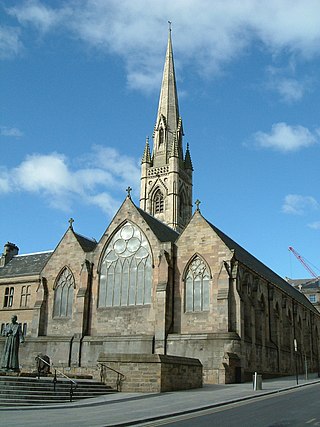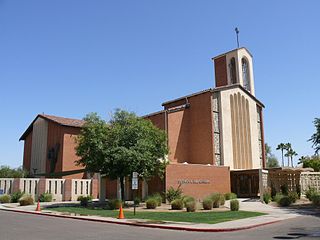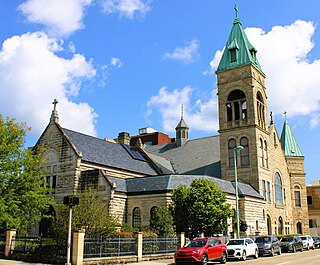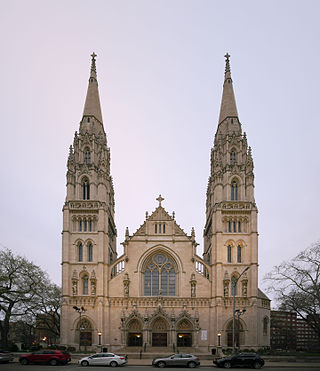
St. Raphael's Cathedral is a Catholic cathedral and a parish church in the Archdiocese of Dubuque located in Dubuque, Iowa. The parish is the oldest congregation of any Christian denomination in the state of Iowa. The cathedral church, rectory, former convent, and former parochial school building are contributing properties in the Cathedral Historic District on the National Register of Historic Places.

The Cathedral Church of St Mary is a Catholic cathedral in Newcastle upon Tyne, Tyne and Wear, England. It is the mother church of the Diocese of Hexham and Newcastle and seat of the Bishop of Hexham and Newcastle. The cathedral, situated on Clayton Street, was designed by Augustus Welby Pugin and built between 1842 and 1844. The cathedral is a grade I listed building and a fine example of the Gothic Revival style of architecture championed by Pugin.

Sacred Heart Cathedral, located in Davenport, Iowa, United States, is a Catholic cathedral and a parish church in the Diocese of Davenport. The cathedral is located on a bluff overlooking the Mississippi River to the east of Downtown Davenport. It is listed on the National Register of Historic Places as part of the Sacred Heart Roman Catholic Cathedral Complex. This designation includes the church building, rectory, and the former convent, which was torn down in 2012. The cathedral is adjacent to the Cork Hill Historic District, also on the National Register. Its location on Cork Hill, a section of the city settled by Irish immigrants.

The Cathedral of Saint Patrick is the seat of the Roman Catholic Church in Charlotte, North Carolina, United States of America. It is the mother church of the Diocese of Charlotte and is the seat of its bishop. In 1987 it was included as a contributing property in the Dilworth Historic District, listed on the National Register of Historic Places.

The Basilica-Cathedral of St. John the Baptist in St. John's, Newfoundland and Labrador is the metropolitan cathedral of the Roman Catholic Archdiocese of St. John's, Newfoundland and the mother church and symbol of Roman Catholicism in Newfoundland. The building sits within the St. John's Ecclesiastical District, a National Historic District of Canada.

The Cathedral of St. Joseph in Hartford, Connecticut, United States, is the mother church and seat of the Archdiocese of Hartford. Dedicated on May 15, 1962, it stands on the site of the old cathedral which had been destroyed in a fire. It is located on Farmington Avenue just outside downtown Hartford.

Saint Joseph Cathedral is located at 50 Franklin Street in downtown Buffalo, New York within the Joseph Ellicott Historic District, and is currently the cathedral church of the Roman Catholic Diocese of Buffalo.

The Cathedral of Saints Simon and Jude is the cathedral of the Roman Catholic Diocese of Phoenix in Phoenix, Arizona in the United States. As of 2025, the rector of the cathedral is Monsignor Matthew Henry.

The Diocese of Little Rock is a Latin Church ecclesiastical jurisdiction or diocese of the Catholic Church for Arkansas in the United States. It is a suffragan diocese in the ecclesiastical province of the metropolitan Archdiocese of Oklahoma City.

The Cathedral of St. John the Baptist is the mother church of the Roman Catholic Diocese of Charleston, located in Charleston, South Carolina. Designed by Brooklyn architect Patrick Keely, the construction of the cathedral started in 1890 to replace a cathedral that burned down in 1861. St. John the Baptist was dedicated in 1907.

The Cathedral of Saint Mary is the seat of the archbishop of the Roman Catholic Archdiocese of Miami. The cathedral is named for Mary, mother of Jesus, and is located at 7525 N.W. 2nd Avenue, Miami, Florida, United States. Since June 2010, Archbishop Thomas Gerard Wenski has served as the archbishop of Miami, Rev. Christopher Marino is the cathedral's rector.

The Diocese of Wagga Wagga is a Latin Church suffragan diocese of the Archdiocese of Sydney, established in 1917, covering the Riverina region of New South Wales in Australia.

John Baptist Morris was an American prelate of the Roman Catholic Church. He served as bishop of the Diocese of Little Rock in Arkansas from 1907 until his death.

St. John Gualbert Cathedral is the co-cathedral of the Roman Catholic Diocese of Altoona–Johnstown, located in Johnstown, Pennsylvania, United States. It is also a contributing property in the Downtown Johnstown Historic District on the National Register of Historic Places.

The Basilica of the Co-Cathedral of the Sacred Heart is a cathedral church and a minor basilica located in Charleston, West Virginia, United States. Along with the Cathedral of St. Joseph in Wheeling it is the seat of the Catholic Diocese of Wheeling-Charleston. The parish complex is a contributing property in the Downtown Charleston Historic District on the National Register of Historic Places.

The Cathedral of the Immaculate Conception is a Catholic cathedral in Kansas City, Missouri, United States. Along with the Cathedral of St. Joseph it is the seat of the Diocese of Kansas City-St. Joseph. It is a contributing property in the Quality Hill neighborhood, which is listed on the National Register of Historic Places.

The Cathedral of St. Mary of the Assumption, also known simply as St. Mary's Cathedral, is the Catholic cathedral in Trenton, New Jersey, United States. Along with the Co-Cathedral of St. Robert Bellarmine in Freehold, it is the seat of the Diocese of Trenton.

St. Joseph Cathedral is a Catholic cathedral located in Columbus, Ohio, United States which serves as the seat of the Diocese of Columbus. The church building, completed in 1878, is located on Broad Street in Downtown Columbus.

Saint Paul Cathedral is the mother church of the Diocese of Pittsburgh in Pittsburgh, Pennsylvania. St. Paul parish was established in 1833.

Trinity Episcopal Cathedral is an historic church building at 310 West 17th Street in Little Rock, Arkansas, United States. It is the seat of the Diocese of Arkansas and is listed on the National Register of Historic Places.























